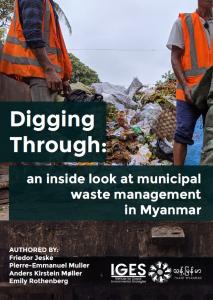The purpose of this paper is to provide an up-to-date analysis of urban SWM practices and the latest SWM data in Myanmar for use by various stake-holders, especially international development consultants and municipalities. Urban governance structures in Myanmar differ greatly between Myanmar’s three largest cities of Yangon, Mandalay and Nay Pyi Taw – which each hosts a governing City Development Committee (CDC) with a dedicated Cleansing Department for waste management2 – and secondary cities, which operate through a more simplified municipal body called a Development Affairs Organization (DAO). While the focus of this paper is Myanmar’s secondary cities, SWM data from primary cities are in some cases included as points of comparison or case studies. For the purposes of this report, “municipalities” refers to all municipal bodies, including both CDCs and DAOs.
This paper aims to:
1. Provide an overview of current SWM structures and challenges in Myanmar;
2. Collate and analyze the most up-to-date SWM data from across the country, which can provide an empirical basis for better municipal SWM planning for both development specialists and policy makers;
3. Compare this local field data with global predictions for Myanmar and other data from the surrounding regions, highlighting key differences between the two.

